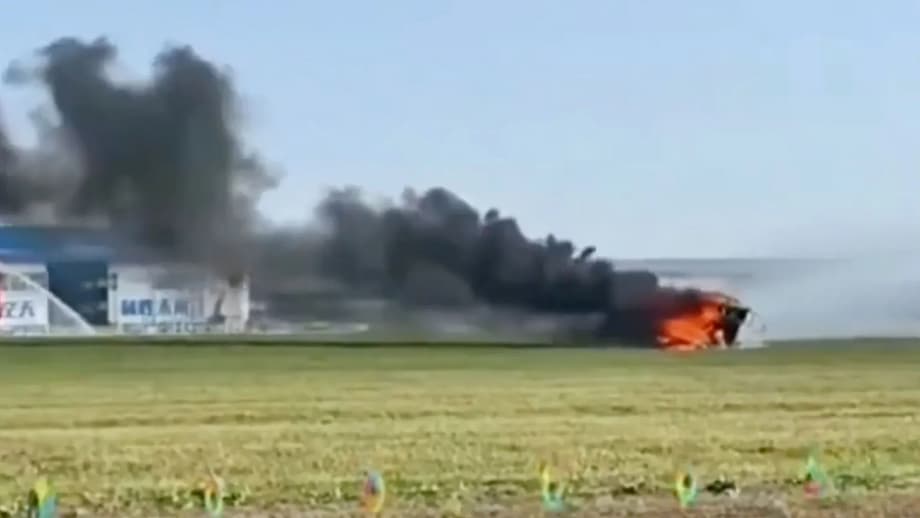A collision at a showcase event
Two flying cars from Xpeng AeroHT collided in flight during a rehearsal for the Changchun air show in Jilin Province on Tuesday afternoon. The practice demonstration was meant to highlight a new class of personal aircraft, instead it ended with one vehicle catching fire after landing and emergency crews dousing the flames. The other aircraft returned to the ground without igniting. Local officials cordoned off a section of the field and cleared the area. The air show is scheduled to open later in the week in northeast China.
Xpeng AeroHT, the aviation unit of the Chinese electric vehicle maker, said the incident occurred when two aircraft flew too close together during a formation exercise. The company attributed the contact to insufficient spacing and said an internal investigation had begun. A company employee said one pilot suffered minor injuries. The manufacturer said all personnel at the scene were safe. Video posted on Chinese social platforms showed dark smoke rising from a grassy area as fire engines surrounded the damaged craft.
These aircraft, known as electric vertical takeoff and landing vehicles (eVTOL), can take off and land vertically using multiple electric rotors. They are designed for short city hops at low altitude and can be piloted or operate with varying levels of automation. Xpeng has promoted the technology for years and has stated an intention to sell units around 2 million yuan, roughly 280,000 to 300,000 dollars. The firm has spoken of thousands of reservations and is preparing a modular system that pairs a road vehicle with an aerial module. The Changchun flight was planned as one of the highest profile demonstrations to date.
What happened in the air
Early descriptions indicate the collision happened during a dual aircraft formation drill when the two craft clipped each other. In a statement, Xpeng AeroHT pointed to a lack of separation between the vehicles as the immediate cause, with one aircraft suffering damage to its fuselage that led to a fire after landing. Emergency teams responded quickly and the site was secured within minutes, according to the company.
In a written statement, Xpeng AeroHT summarized the situation and the response in plain terms.
All personnel at the scene are safe. An investigation is underway.
How investigators reconstruct events
Investigators will study flight logs, radio calls, video recorded by spectators and on board telemetry to map the sequence of events. Modern eVTOL prototypes stream large amounts of data during tests, including rotor speed, battery status, accelerations and GPS tracks. The team will look at formation briefings, the exact distance between aircraft, wind conditions, and whether any automated stability features activated as the aircraft came close. The goal is to isolate human factors, technical issues, or a mix of both.
Inside Xpeng AeroHT flying car program
Xpeng AeroHT is a subsidiary of Xpeng that focuses on aerial mobility. The company describes itself as the largest flying car developer in Asia. It has shown two main concepts, a self contained two seat eVTOL and a modular system known as the Land Aircraft Carrier that uses a ground vehicle to store, recharge and transport an aerial module. Demonstration flights have been staged in several Chinese cities to build public familiarity.
As of January, Xpeng said it had around 3,000 orders for its flying vehicle line. Company leaders have talked about a price near 2 million yuan, a figure that places the first models near high end luxury cars. The plan is to begin deliveries of the modular system in 2026, subject to approvals and production readiness. The company has also promoted a network of flying camps, sites with dedicated takeoff and landing zones and controlled airspace where users can receive training and experience supervised flights.
Why China is banking on low altitude mobility
Beijing has made the low altitude economy a priority. The idea covers activities under roughly 3,000 meters, from parcel drones and medical supply runs to aerial sightseeing and short urban hops. China has more than 2,000 drone manufacturers and over 20,000 companies that operate unmanned aircraft. Several cities now run pilot programs for routine deliveries and emergency support using drones.
China’s civil aviation regulator has projected a domestic market approaching 206 billion dollars by 2025 and about 482 billion dollars by 2035. Manufacturers such as Xpeng AeroHT want to supply platforms for tourism, logistics, agriculture and disaster relief. The Changchun air show is part of a push to make these services tangible to the public and to signal confidence in near term commercialization.
Safety questions and the long route to certification
The collision underscores how early this sector remains. eVTOL aircraft promise quiet flight and lower maintenance, yet they must prove reliability in varied weather, crowded urban airspace and daily use. In established aviation, approvals require rigorous testing and detailed maintenance programs. Regulators will demand evidence on battery performance, redundancy of motors and controllers, and the resilience of flight control software.
Airworthiness certification for passenger services is complex. In the United States and Europe, agencies have created new pathways tailored for eVTOL. China is crafting its own framework. The first commercial approvals in any country will likely limit routes, altitudes and weather conditions. Training will also matter. Even if many flights are highly automated, operators and safety pilots need clear procedures, recurrent checks and consistent standards.
Airspace integration and training
Urban areas already host helicopters, medical flights and drones. Safe integration depends on reliable traffic management, geofencing, clearance procedures and strict separation rules. Formation flying by test pilots can be part of air show routines, but it increases risk if spacing or coordination slips. The Changchun rehearsal involved close formation work, a demanding task that requires precise timing and a shared plan before takeoff.
Formation flying explained
Formation flights reduce the buffer that normally keeps aircraft apart. Small errors in speed, altitude or heading can close gaps fast. Rotor wash and turbulence from one aircraft can upset the other. Pilots mitigate this by assigning roles, setting precise distances and using constant sight references. In a rehearsal environment, crews often repeat maneuvers multiple times. If a misjudgment occurs, there is little time to recover when aircraft are low and close to each other.
Market and business stakes for Xpeng
The incident arrives during a period of intense competition in Chinese electric transport. Xpeng, already a major electric car maker, has expanded into Europe and has pitched flying vehicles as a next frontier for mobility. The crash could drive the company to revisit demonstration protocols, increase separation during displays and refine training for formation routines. It may also prompt extra scrutiny from local regulators before the show opens.
Regional outlets reported that preparations for the Changchun event continued after the crash scene was cleared. The company has said authorities completed the response and that it is investigating. In the car business, Xpeng recently dealt with a recall of P7 Plus sedans related to a steering fault. Potential buyers of the flying vehicle and investors will look for updates on safety measures, program milestones and any adjustments to the public flight schedule.
What to Know
- Two Xpeng AeroHT flying cars collided in flight during a rehearsal for the Changchun air show in Jilin Province.
- One aircraft caught fire after landing while the other landed safely; local officials secured the site.
- The company said all personnel at the scene were safe; a company employee said one pilot had minor injuries.
- Xpeng AeroHT cited insufficient spacing during a formation drill as the immediate cause; an investigation is underway.
- Videos on Chinese social platforms showed smoke and fire crews around the damaged craft.
- The vehicles are eVTOL aircraft designed for short flights at low altitude; the firm has discussed pricing near 2 million yuan and thousands of reservations.
- China is promoting a low altitude economy, with market forecasts of about 206 billion dollars by 2025 and about 482 billion dollars by 2035.
- Certification, training, and airspace integration remain key safety challenges for commercial passenger use.
- The incident may lead to tighter display protocols and added scrutiny ahead of the air show opening.




